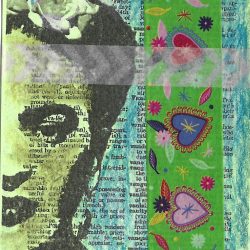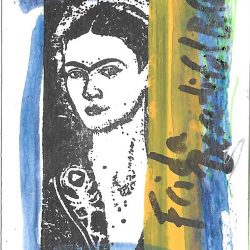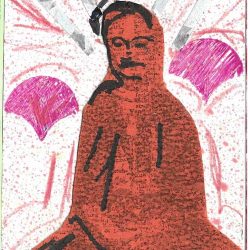Quick tip: Artist Trading Cards (Quick Tip)
Frida-Inspired Artist Trading Cards
By Michelle Harrell, NCMA Director of Education
Artist Trading Cards (ATCs) are a collaborative cultural performance art form created in 1997 by Swiss artist M. Vänçi Stirnemann. Each work of art is unique, signed by the artist, and the size of sports trading cards: 2 1⁄2 by 3 1⁄2 inches (64 mm × 89 mm). Now anyone can make ATCs! Adults and students both enjoy this activity. You can use colored pencils, markers, stamps, or any media you have available. Just be sure you use the proper size for trading to be able to call it an Artist Trading Card.
In anticipation of the Frida Kahlo, Diego Rivera, and Mexican Modernism from the Jacques and Natasha Gelman Collection exhibition, we traveled across the state making and exchanging Frida-inspired ATCs. Since Kahlo’s death in 1954, she has become an international pop icon adapted to represent feminism, Latinx culture, and accessibility. Her distinctive look can be seen on a variety of merchandise including Frida stamps and Frida ATC backgrounds. The image gallery above features the Frida-inspired ATCs created by students and teachers.
Here are strategies to incorporate ATCs in your classroom:
- Vocabulary Flashcards. Divide students into small study groups to quiz each other using a set of ATC flashcards they create together. Each student among the group creates three to five ATCS with a definition on one side and an illustration on the other side. Have groups exchange flash card sets with other groups to review terms.
- Character Study. Upon completing a book study, have students create an ATC for various characters in the style of sports trading cards where a portrait of the character is on one side and important statistics on the opposite side (name, age, hometown, and a characteristic from the book being studied).
- ATC exchange. Connect with a class through https://www.penpalschools.com to exchange ATCs. Have your students create three ATCs to portray their identity: one to keep, one to trade with a classmate, and one to trade with another class.
- Memory Matching. Give each student two blank cards. On one, write a vocabulary word so the text fills the space in an interesting way. On another card, have students illustrate the vocabulary word with its definition.” Shuffle all cards and lay face down in row. Have students take turns flipping cards trying to match cards like the children’s game of Memory.
- Composition ATCs (Idea from Jodi Aker). On one side of a set of cards, students create original works of art using a different element of art and/or principle of design. On the other side, they label the compositional device they used. Have students play a guessing game identifying which element or principle was used in each ATC.
- Math Mini-Masterpieces. Give students three cards each. Have students write the three types of angles on each card: obtuse, right, and acute. Then, students draw that angle on the opposite side and turn it into animal, flower, or whatever students want to make it into. Students can use the cards as flashcards to remember each type of angle.
- Links




